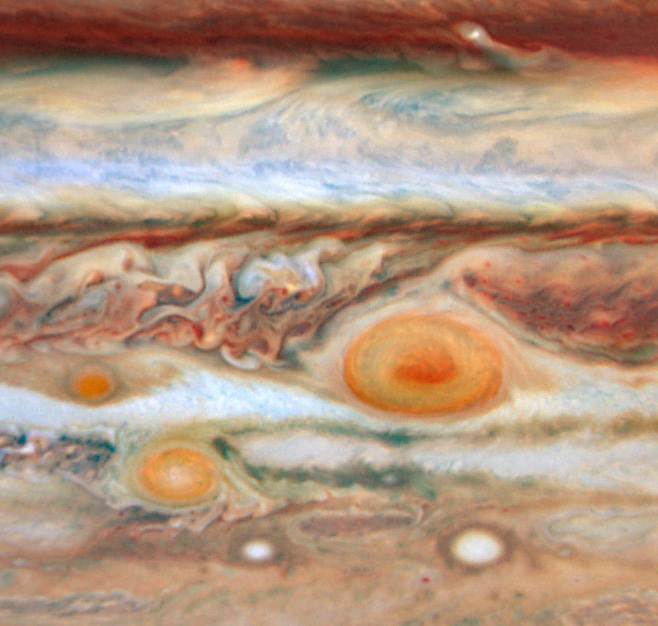Jupiter appears to be breaking out with spots, as a third red storm has joined the Great Red Spot and Red Spot Jr. (or Oval BA) in the planet’s turbulent atmosphere. This third spot used to be a white storm, and its change to a red color might mean the storm is becoming more powerful. Astronomers believe these new images captured by both the Hubble and the Keck telescope may show that Jupiter is undergoing a major climate change, as was predicted four years ago.
“One of the most notable changes we observe in both the Hubble and Keck images is the change from a rather bland, quiescent band surrounding the Great Red Spot just over a year ago to one that is incredibly turbulent at both sides of the spot,” said Imke de Pater from the University of California Berkley. “During all previous HST observations and spacecraft encounters, starting with Voyager in 1979, such turbulence was seen only on the west or left side of the spot.”
The Great Red Spot has been around as long as 200 to 350 years, based on early telescopic observations. If the new red spot and the Great Red Spot continue on their courses, they will encounter each other in August. Astronomers will keep a close watch on whether the small oval will either be absorbed or repelled from the Great Red Spot. Red Spot Jr. which lies between the two other spots, and is at a lower latitude, will pass the Great Red Spot in June.
The Great Red Spot is a persistent, high-pressure storm whose cloud head sticks some 8 kilometers (5 miles) above the surrounding cloud deck. The new spot is much smaller than the other two and lies to the west of the Great Red Spot in the same latitude band of clouds.
The visible-light images were taken by Hubble’s Wide Field Planetary Camera 2 on May 9 and 10, and near-infrared adaptive optics images were taken by the W.M. Keck telescope on May 11.
These images may support the idea that Jupiter is in the midst of global climate change, as first proposed in 2004 by Phil Marcus, a professor of mechanical engineering at the University of California, Berkeley. The planet’s temperatures may be changing by 15 to 20 degrees Fahrenheit. The giant planet is getting warmer near the equator and cooler near the South Pole. He predicted that large changes would start in the southern hemisphere around 2006, causing the jet streams to become unstable and spawn new vortices.
“The appearance of the planet’s cloud system from just north of the equator down to 34 degrees south latitude keeps surprising us with changes and, in particular, with new cloud features tha haven’t been previously observed,” said Marcus. “Whether or not Jupiter’s climate has changed due to a predicted warming, the cloud activity over the last two and a half years shows dramatically that something unusual has happened.”
Original News Source: Hubble Press Release


I’m certain that by the end of the week, someone on the Cloudy Nights forum will have claimed to have seen it in their 6×30 finderscope! =-P
I’m curious if I’ll be able to spot it in my 10″ Dob. Jupiter is pretty far south this year, so I’m not holding out too much hope, but it won’t stop me from trying!
global warming on jupiter???
how did we do that??
gosh darn suv’s are screwing up the whole solar system now!!!
can we do “cap and trade” with the jovians??
i bet algore can whip us up a few carbon credits.
this just cannot happen- the sun doesnot /cannot/willnot cause global warming-
but the pictures are pretty cool
The trio of storms is already clearly visible in this amateur Jupiter movie from late April shot with a methane filter.
Another beautiful image from the Hubble team! Keep up the good work!
Oops! Two minor corrections to my above comment:
1: The “15 to 20F is 7.22 to 10C” refers to a temperature increase.
2: By surface temperature I of course mean approx. cloud top temperature.
“These images may support the idea that Jupiter is in the midst of global climate change, as first proposed in 2004 by Phil Marcus, a professor of mechanical engineering at the University of California, Berkeley.”
Top job so far, Mr. Marcus! Let’s see if it bears out…
Thanks Nancy, very interesting article.
Couldnt you make it a bit more scary ?
Like doomsday when the new red dot meets the big one in August ?
Ask Ian he knows how to sparkle.
Why Jupiter is going through that major climate change? Is there a particular reason?
August should be pretty interesting. Jupiter will be high in the sky in early evening, a great time to check out the possible merger of the two spots, if it happens.
Another dagger in the false claims of global warming caused by human activity.
Marcellus,
Try plugging the numbers into the Stefan-Boltzmann equation.
I’m pretty sure that if increased output from the Sun were to increase the temperature by 10K all the way out in Jupiter’s orbit, we’d have something like 25 times that increase here on earth.
So how do you explain that we’re not all on fire, if Terran warming isn’t anthropgenic?
Elias –
Don’t you read the news?? It is obvious…. We are the cause of the accelerated climate change… There couldn’t be another explanation.
Don’t we have a satellite hanging around there now? .. That must be it.. That must be the cause. We can’t have accelerated climate change without human intervention, right?